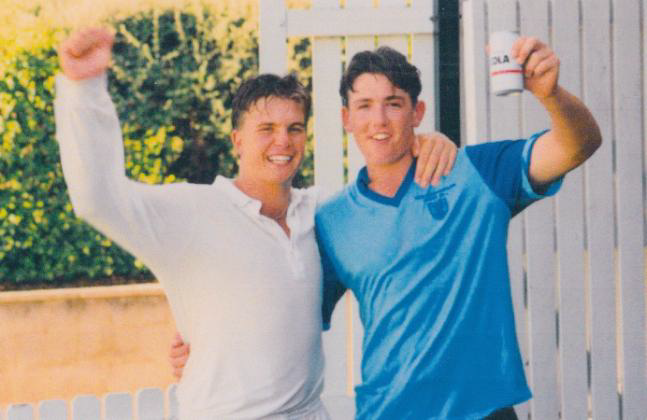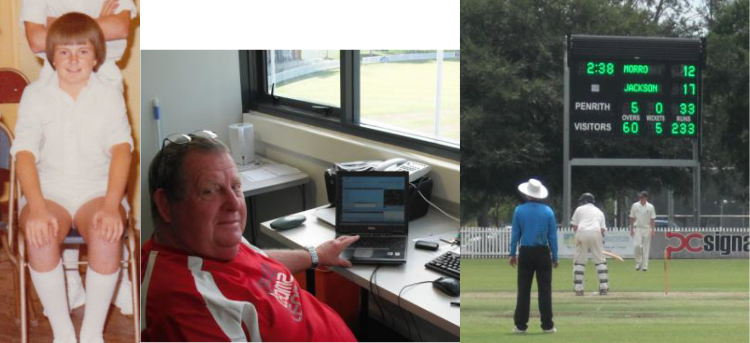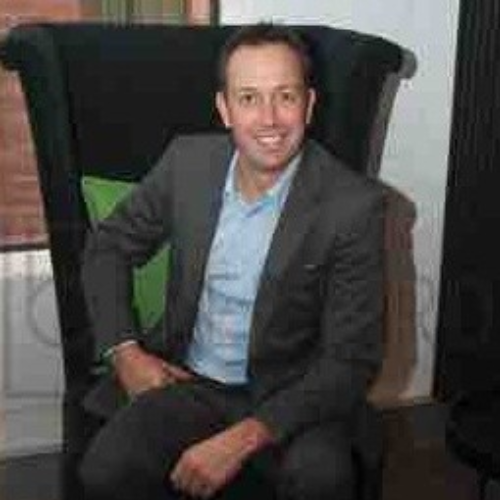The old saying, ‘One door closes, another opens’ never rang truer than with this Presentation Night announcement: “ ... and the winner of the Club’s Swire Travel Rookie Of The Year Award is Paul Goldsmith”. Paul was a rookie in every sense of the word: as a student at Blacktown High his right-arm fast bowling had caught the eye of his teacher Dean Lane, who was a Penrith cricketer, and who suggested to Paul that he should attend a pre-season trial. Paul was graded in Fourths, and, after a six-wicket haul against Waverley, was promoted. He then took 15 wickets in Thirds and was promoted. He then took another 16 wickets in Seconds. His season swag was 38 wickets @ 17.40, and he was rated “without a doubt a bowler with a bright future”.
As Paul strode onto the scene, one of the old and bold, Ron Halse(#), exited. The wily swing- bowler and more than handy late-order batsman decided his bung knees had had enough. He was one of only three players to have achieved 200 wickets and 2000 runs for the Club. At various stages he had captained Seconds, Thirds and Fifths. He was a key member of the Club’s First-Grade Premiership- winning team in 1978/79, coincidentally his best season (29 wickets @ 9.62 and 279 runs). In his career with Penrith he scored 2404 runs @ 17.04 and took 322 wicket @ 19.07. He was heavily involved with coaching and development of young players and in later years coached our first winning AW Green Shield team. He would also coach the NSW Women’s team from 1991 to 1994. He would be Club President from 1997 to 2005.
This season did not start well. Fire tore through the pavilion and damage was estimated at $15000, including loss of a new two-door commercial refrigerator. Penrith RSL Club immediately recognized the psychological impact this loss might have in a long hot summer and generously donated a replacement. Penrith City Council’s prompt response in replacing the kitchen, stove and carpet was greatly appreciated, too. But, nothing could replace the damage to the Club’s photographic history. Many memories were lost.
Cricket was mixed. The Women achieved an encore, winning the Thirds Premiership. A ‘Men’s’ encore was less pleasing—13th in the Club Championship. First Grade had their worst season since the 1970s. The best results were the Fourths, third, and Thirds, one win out of the Semi-finals. In the age competitions, the Green Shield lost out in a rain-affected Semi-final, but the Poidevin-Gray, where Penrith, a youth stronghold, should always be competitive, were poor. The Committee retained confidence in the Club’s rebuilding program, and, it was not misplaced: two of the Club’s younger cricketers, Jason Arnberger and Geoff Sullivan were named as captains of their respective State age representative teams, Jason NSW U/19s and Geoff NSW U/17s; and, two of their team members were Nathan Rennie (U/19) and Garry Sheen (U/17). And, in the Fifth Grade, Jason Benton, a right- hander well suited to the middle-order, powerful, with strokes all around the wicket, and a smart fielder, and, who was part of the Development Squad and still of Green Shield age, set a Club Individual Highest Score Record of 205 not out.
Financially, for the first time the Club’s turnover passed the century, $109k. In the Club’s first season, 1973/74, turnover was $7k, and, in ensuing years it would reach $345k. Costs associated with running a Grade Cricket Club were clearly bringing pressure to the traditional roles of the volunteers, those selfless people who offer their time free of charge.
First Grade (20th-12 pts)
We had to go back to our second season, 1974/75, to remember a season as bad. Back then there was an excuse of sorts—‘the second season blues’, a common tale of woe when successful new boys are exposed to the tactical blowtorch by wily opponents. But after 19 Grade seasons many thought this one the ‘unacceptable blues’.
Rod Bower crossing to Balmain left a hole, as did the absence of Craig Bayliss and Kevin Ivins to work commitments. When Trevor Bayliss was absent on NSW duties Steve Kennaugh was captain. It had been quite a rise, and a fitting tribute for his hard work. He had just one full season of First Grade under his belt. Welcome to the ‘deep end’, Steve. His captaincy was of a high standard and, “he will play an important role in the Club’s future development,” said Secretary Bill Ball. Some young players introduced to First Grade were Jason Arnberger and Karl Danenbergsons. Kennaugh liked the pairing of Danenbergsons, off-spin (21 wickets) to partner Paul Thomas, left-arm orthodox, to provide balance. “The duo was regularly called on to make the early breakthrough and more often than not got it,” he said. Kennaugh lamented “a lack of dedication on the field and at training.” Eight catches went down in the last match.
Highlights
- Trevor Bayliss (nine innings) scored 454 runs @ 56.75, including 159 v Petersham, 112 v St George and 59 v Northern District
- Barry Coad scored 383 runs @ 31.91, including 92 v Fairfield, 67 v Hawkesbury and 52 v Petersham
- Steve Kennaugh scored 334 runs @ 25.69, including 83 v Sydney Uni; took 15 wickets @ 34.33
- Greg Sheens scored 322 runs @ 32.20, including 78 v Petersham and 52 v St George
- Tim Fraser scored 186 runs @ 18.60, including 74 v Uni NSW; took 13 wickets @ 35.61, including 5/35 v Waverley
- Michael Wholohan scored 298 runs @ 29.80, including 79* v Uni NSW, 59 v Bankstown and 58 v Sutherland
- Jason Arnberger scored 265 runs @ 29.44, including 74* v St George and 73 v Sutherland
- Paul Thomas took 31 wickets @ 25.61, including 6/140 v Petersham
- Michael Wholohan and Tim Fraser set a Club Record 8th Wicket Partnership of 124 v Uni NSW
Runs for: 3104 Wickets lost 121 Average 25.65
Runs against: 3297 Wickets taken 102 Average 32.33
Second Grade (8th-42 pts)
Greg Douglas, in his second season as Seconds captain, finished with a spring in his step. This was his assessment: “At Christmas we had two wins and were in 17th spot. I don’t know what the players were served on Christmas Day but our run after Christmas went like this: Manly, washed out draw; Hawkesbury, 1st Innings win; Northern District, 1st Innings win; Sydney Uni, 1st Innings win; North Sydney, 1st Innings win; St George, 1st Innings win; Sutherland, 1st Innings loss.” He concluded: “If we start the (next) year in the same way we finished (the last), fingers-crossed, a Semi- final berth.” The signs were there.
Douglas led the batting, which was the team’s strength; there were 19 scores of 50-plus including two centuries. He had a good’un in Garry Sheen. “Magnificent hands in the field, and a tremendously gifted stroke-maker, a very level head and all that at 16,” said Douglas.
The bowling lacked a striking quick until the arrival of Paul Goldsmith on his journey from Fourths; there were five hauls of five-wickets-plus, the main man being left-arm orthodox Phil Chie. Douglas again: “’Dusty’ or ‘Mr December’, call Phil what you like, but he gets the job done. Could easily still play First Grade.”
Highlights
- Greg Douglas scored 371 runs @ 26.50, including 75 v Randwick
- Scott Will scored 330 runs @ 27.50, including 55* v Hawkesbury
- Brett Wheeldon scored 316 runs @ 28.72, including 74* v Sutherland and 71 v St George; took 12 wickets @ 21.91, including 5/30 v Sydney Uni
- Grant Parmenter scored 314 runs @ 31.40, including 58 v St George and 57 v Northern District
- Garry Sheen scored 279 runs @ 23.25, including 67 v Randwick and 60 v Sydney Uni
- Nathan Rennie (seven innings) scored 210 runs @ 33.00, including 60 v Sutherland and 56 v St George
- Murray Rayner (six innings) scored 208 runs @ 34.66, including 86 v Bankstown
- Charlie Doyle (nine innings) scored 205 runs @ 41.00, including 59 v Sutherland
- Greg Sheens (five innings) scored 200 runs @ 50.00, including 119 v Bankstown
- Andrew Bennett scored 191 runs @ 23.87, including 52* v Mosman and 51 v Fairfield; took 21 wickets @ 21.05, including 6/32 v Hawkesbury
- Jason Arnberger scored 104 v North Sydney
- Phil Chie took 30 wickets @ 16.30, including 6/66 v Bankstown
- Paul Goldsmith took 16 wickets 20.37, including 5/47 v Sydney Uni
- Karl Danenbergsons took 12 wickets @ 21.91, including 6/89 v Waverley
Runs for: 3755 Wickets lost 146 Average 25.71
Runs against: 3569 Wickets taken 140 Average 25.49
Third Grade (5th-48 pts)
Captain Rod Evans was disappointed to miss the Semi-finals by one win, but said: “Here’s the good news, the Junior policy is working well. I tender the names Sheen, Rayner, Lane, Maraziotis, Goldsmith and Sullivan.” A quick look at the Highlights confirmed his optimism, most notably the ten scores of 50-plus including three centuries and those massive Wicket Partnerships. They are the statistics that denote ‘character’ and ‘temperament’ as much as talent. Evans described Sheen’s unbeaten century against Waverley as “unforgettable”; Maraziotis as “a versatile cricketer, capable of batting anywhere and a wily bowler of ‘chinamen’; Rayner, a “good fighter and concentrates well”; Sullivan, a “good team player and thinker”; Lane “has the potential to play First Grade”; Goldsmith, “sharp and moves the ball away nicely”.
Highlights
- Shannon Lane scored 359 runs @ 44.87, including 169 v Hawkesbury, took 16 wickets @ 22.00, including 6/97 v Hawkesbury
- Darren Morris scored 303 runs @ 30.30, including 85 v Hawkesbury, 55 v Petersham and 51 v Uni of NSW
- Garry Sheen (four innings) scored 294 runs @ 98.00, including 154* v Waverley and 94 v Uni NSW, promoted to Seconds
- Murray Rayner (four innings) scored 241 runs @ 60.25, including 122 v Fairfield and 73 v Waverley; promoted to Seconds
- Paul Maraziotis scored 294 runs @ 29.40, including 56 v Sutherland; took six wickets @ 29.66, including 6/69 v Sutherland
- Geoff Sullivan (eight innings) scored 182 runs @ 22.75, including 65 v Northern District
- Phil Chie took eight wickets @ 13.75, including 5/65 v Fairfield; promoted to Seconds
- Paul Goldsmith took 15 wickets @19.13; promoted to Seconds
- Murray Rayner and Garry Sheen set a Grade Record 2nd Wicket Partnership of 222 v Waverley
- Darren Morris and Shannon Lane set a Club Record 3rd Wicket Partnership of 236 v Hawkesbury
Runs for: 2619 Wickets lost 95 Average 27.56
Runs against: 2681 Wickets taken 118 Average 22.72
Fourth Grade (3rd-55 pts)
Like Steve Kennaugh, Matt Langdon was making his debut as a Penrith Grade captain. And, what a debut it was. Fourths lost only one game, to Sydney University, and, played a thrilling tie against the other University (NSW), 258 all.
The Semi-final against Minor Premiers Gordon was a tough gig. On a belter at Chatswood Oval, Gordon won the toss and batted ... and batted, well into the afternoon of Day two, Penrith eventually dismissed them for 440. There was two and a half hours of the match remaining, a classic case of a ‘no- win’ situation. Still, 4/183 at stumps with Langdon on 73 and Buttigieg on 39 was full of character. Langdon noted that his team’s determination to field well and to stay positive was still running strong after a day and a half in the field. “It is a good thing we enjoy fielding,” he said.
Secretary Bill Ball made a personal plea to Langdon: “The Club hopes that you will be able to captain and guide many more of our young players in the seasons ahead.”
Highlights
- Matt Langdon scored Season Highest Club Aggregate 616 runs @ 44.00, including 95 v Uni of NSW, 86 v Sydney Uni, 73 v Gordon and 58* v Hawkesbury,
- Hratch Sekzenian scored 361 runs @ 36.10, including 74 v Gordon, 69 v Waverley, 56 v Bankstown and 51 v Sutherland
- Warren Buttigieg scored 249 runs @ 22.63, including 72 v Randwick; took 19 wickets @ 22.05
- Mason Baylis scored 187 runs @ 20.77, including 83 v Randwick
- Geoff Sullivan (five innings) scored 178 runs @ 35.60, including 58 v Waverley
- Jason Benton (four innings) scored 89 runs @ 29.66, including 50* v Hawkesbury
- Peter Sredojevic took 30 wickets @ 19.70, including 7/39 v Petersham and 5/36 v St George
- Paul Goldsmith took six wickets @ 6.50, including 6/39 v Waverley
- Paul Devaney took 13 wickets @ 13.15, including 6/39 v Bankstown
- Wayne Ball took 12 wickets @ 24.50, including 5/19 v Mosman
Runs for: 2809 Wickets lost 116 Average 24.21
Runs against: 2853 Wickets taken 148 Average 19.27
Fifth Grade (10th-38 pts)
Fifths ran out of puff. With three rounds to go they were threatening for the Semi-finals, but lost every match. Batting, previously the team strength, lost momentum. Retiring Captain Ron Halse made this point about the Fifths: “During the past two seasons we—two oldies trying to pull it all together— have tried to provide opportunity for the many talented youngsters in the area. The reasons for this are twofold, firstly to provide them with a base on which to build their Grade careers and, secondly, to ensure the Club receives a steady flow of talented Juniors to the higher Grades. Hopefully, we have succeeded more times than not. It is important in the long term that this philosophy is continued.”
Highlights
- Jason Benton scored 462 runs @ 57.75, including 205* v Petersham, 66 v Waverley, 65 v Sydney Uni and 59 v Gordon; promoted to Fourths
- Russell Holley scored 395 runs @ 24.68, including 88 v Waverley and 62 v Randwick
- Matthew Manton scored 172 runs @ 34.40, including 73* v Northern District; took 14 wickets @ 21.00, including 5/26 v Uni NSW; promoted to Fourths
- Adam Webb scored 147 runs @ 36.75, including 66* v Bankstown; promoted to Fourths
- Shane Greggs scored 100* v Waverley; promoted to Fourths
- Mark Comber scored 138 runs @ 46.00, including 87* v Hawkesbury; promoted to Fourths
- Scott Roseby took 16 wickets @ 14.31, including 7/32 v Bankstown; promoted to Fourths
- Ron Halse took 15 wickets @ 20.26, including 5/67 v Sydney Uni
Runs for: 3095 Wickets lost 125 Average 24.76
Runs against: 2708 Wickets taken 117 Average 23.14
Colts
Kevin Lalor, a young swing bowler, was another captaincy debutant. He was confronted by some familiar, but not always ‘friendly’, faces. He noted: “In the local Nepean A-Grade competition there are teams with players who have had Grade experience, Gary Donlan, Chris Gavin, Mark Thistlethwaite and many others.” Tough opponents all, yet the Colts, average age about 16, only just missed the Semi-finals. The concept of a Colts team playing in the NDCA competition has proven successful, giving local Juniors the opportunity to compete in Senior competition, to practise with the Grade teams, and in many cases, earn promotion to Grade. Among the promoted were Damian Duroux, Jason Bishop, Craig Huthnance and, the 14-year-old twins, Anthony and Philip Augustine.
Highlights
- Steve Maraziotis scored 222 runs @ 27.75, including 60 v St Marys
- Brad Astill scored 196 runs @ 24.50, including 71* v St Marys
- Mark Comber scored 65 runs @ 21.66, including 57 v Emu Plains
- Caine Bracken took 11 wickets @ 19.45, including 5/59 v St Marys, promoted
Runs for: 1617 Wickets lost 86 Average 18.80
Runs against: 2230 Wickets taken 88 Average 25.34
Poidevin-Gray
The team was highly regarded, manager Steve Kennaugh echoing the thoughts of many when he said: “On paper this appears to be one of the strongest PG teams Penrith have fielded”. It ended the Competition in unfortunate territory—didn’t win a match—a timely reminder that in cricket a bunch of highly-rated individuals doesn’t always gel into a brilliant team.
Highlights
- Murray Rayner scored 208 runs @ 41.60, including 80 v Northern District and 74* v Manly
- Karl Danenbergsons took 17 wickets @ 20.28, best 4/34 v North Sydney
Green Shield
Challenging, but also nostalgic moments for coach Steve Bishop. He had been with some of his players since the Nepean Under-10s and now bid them fond farewell. Wet weather played havoc, challenging Steve’s planning. Round one was a complete wash-out and would be replayed at the end of the rounds. Round six, we went all the way to Gosford in teeming rain ... only to find a ground underwater and not a Gosford official in sight. No mobile phones in those days. Round seven was a rip-snorter, and a nail-biter rolled into one. On a wet Howell pitch North Sydney closed at 8/58. Our openers handled the dicey conditions with maturity, the declaration being made at 1/66. Norths did better the second time around, setting Penrith a target of 154, which we knocked off but with eight wickets lost. In ensuing seasons, administrators with no regard to the true grit of the game, would abolish the opportunity to chase outright victory. What a travesty!
Then, more tension ... the Round one replay. State of play: to qualify for the Semi-final, Penrith had to win, venue Merrylands, slow outfield, playing Parramatta. Penrith, first in, set Parramatta 220 (hail the 2-Jasons, Benton 79, and Bishop 43). Parramatta made 143 (leggie Russell Holley 3/21, swing-and-seamer Matthew Manton 2/5).
The Semi-final was at Sydney Uni No.2, Penrith, second in their division to play Randwick, first in theirs. Heavy rain the night before prevented a timely start, but we were on by lunch, sent in to bat on a damp track. Openers Damian Duroux and Jason Bishop had us on a winning way (2/100, Duroux 30, Bishop 23, Benton 20*), then ... thunderstorms hit. Goodbye Penrith.
Highlights
- Damian Duroux scored 324 @ 46.28, including 121 v Balmain and 97 v Waverley
- Jason Bishop scored 221 @ 27.62, including 66 v Balmain
- Jason Benton scored 219 @ 43.80, including 79 v Parramatta
- Garry Sheen scored 159 runs @ 39.75, including 93 v Manly
- Russell Holley scored 175 runs @ 35.00, including 66 v North Sydney
- Matthew Manton scored 110 runs @ 36.66; took 14 wickets @ 12.14, best 4/26 v North Sydney
Runs for: 1540 Wickets lost 51 Average 30.19
Runs against: 1147 Wickets taken 58 Average 19.77
Women’s (1)
Premiers again! It was our second Third-Grade Premiership, but what a topsy-turvy run to glory. Second-placed Penrith played first-placed Randwick in the Semi-final, the winner to go straight to the Grand Final, the loser to play the winner of the other Semi-final in the Final. Randwick only needed a draw to progress.
First twist: the play-off match would be played at our home ground, Rance Oval, so, ground advantage to us. On one of the hottest weekends of the summer Penrith lost the toss. Second twist: Randwick sent us in to bat! We scored a creditable 176, with Tracy Walsh brilliant. Randwick’s approach to the run chase oozed the confidence of their Minor Premier status. Third twist: we rolled them for a paltry 56, Tracy Walsh again to the fore with 4/17, and Kim Horwood 3/14. Penrith were through to the Big One.
Grand Final Day. From dusty and dry to cold and wet! Randwick again, but this time they batted, and much better. We dismissed them at stumps on Day one for 250, Kim Horwood 5/60. Final twist: ‘Hughie’ sent it down all Saturday night, and into the next morning and play did not commence until 2.50pm. Penrith batted out time and at stumps were 4/68, drawing the match and taking the Premiership. Team manager Kim Dolton reported “a few more grey hairs” ... but remained buoyant, so much so that she announced the Women would apply for Second Grade status the next season.
Highlights
- Tracy Walsh scored 450 runs @ 56.25, best 101* (66 mins) and 74 in the Semi-final: took 31 wickets @ 9.90
- Vicki Wilson scored 304 runs @ 30.40
- Kim Horwood scored 245 runs @ 24.50; took 22 wickets @ 15.09
- Elaine Thomas (five innings) scored 117 runs @ 39.00; took 10 wickets @ 7.80
Women’s (2)
This team played Fifth Grade, with many young girls playing their first season of cricket. One of the youngest, schoolgirl Michelle Goszko, was outstanding with both bat and ball, and would go further. The team began well, a win and a narrow loss, but strangely then struggled to raise more than eight players. Captain Nicole Dunkley arrested the high attrition rate by creating ‘a spirit of good sportsmanship, fair play and fun’. “This brought us a full team and better late-season results with a win and two narrow defeats in our last three games,” she said.
Highlights
- Michelle Goszko scored 477 runs @ 39.75, took 21 wickets @ 12.28
- Michelle Bray scored 215 runs @ 30.71
- Shelley Robinson took a hat-trick v Kuring-Gai
YOUNG GUNS
When management decided in 1988/89 to create, and financially back, a Development Squad for local Junior players aged up to 15, it would train on Tuesday afternoons from May through to August at the St Marys Indoor Cricket Centre. In March, about 30 youngster’s trialled and a squad of 17 was chosen. Head coaches were John Rennie and John Benaud, assisted by other senior players. The immediate aim was to strengthen the AW Green Shield, but long term to unearth players with First-class potential. In other words, a cricket production line.
A stand-out feature of the Development Squad was its balance, which was based around the ‘mix’ of an Ashes Squad. John Benaud had recently been involved in the 1989 Ashes selection and he and John Rennie agreed it was worth trying—a mix of seven bowlers, pace and spin, a minimum of three batsmen with potential to open, five other batsmen, and two keepers. There had to be at least one wrist-spinner in the mix, and all-round potential was encouraged. The coaches also had regard for age; some of the boys were as young as 12, but it was felt they were physically and mentally strong enough to cope against the older boys. The first squad was: Jason Benton, Garry Sheen, Todd Marshall, Russell Holley, Geoff Sullivan, Jason Bishop, Ben Rennie, Scott Roseby, Daniel Abercrombie, Ken Thomas, Brian Starkey, Murray Rayner, Brett Leathen, Brad Astill, Michael Nicholls, Adam Bowyer, Caine Bracken.
John Rennie was the boss. His linkman, or Junior talent scout, was Joe Poulter, who would two decades later become the First-Grade Scorer. At St Marys Indoor ‘JR’ (Rennie) split one net into three, two of which utilised bowling machines and the other was a ‘human net’ (‘live’ bowlers). Another full net was used for fielding drills. The boys were taught batting fundamentals via the machines, and then transferred into the human net to face the real thing, trying to put into practice what they had just been taught.
One of the youngest was Geoff Sullivan, a right-hand middle-order batsman and medium-pace bowler, and, remarkably mature and responsible for his age, traits which later prompted Youth Selectors to rank him captaincy material. ‘Sully’ remembers his St Marys days like this:
“JR and JB at the end of a bowling machine, drilling you with technique, astute defence and aggression, whilst nurturing and encouraging each individual’s unique flair. There was bowling action analysis and correction, fielding technique drills and competitions. But, it was more than just drills and practice. JR and JB had a wealth of cricketing experience and knowledge and each conversation or comment had a cricketing lesson at its heart; reading the game, reading an opponent, setting up a plan, building pressure. They were passionate, even driven, about the proper development of the Junior cricketers in Penrith.
“Part of JR’s program was a Country tour, away from the comforts of home and family, a day- after-day week of intense cricket. These were eye-opening experiences, which again strengthened not only our ability to play competitive cricket, often on turf pitches for the first time, but also to build bonds between players and a sense of ‘team’. I was 14 when we went to Griffith, JR, JB and JP (Joe Poulter) heading the ‘road train’. Our lodgings were modest, dormitory style. I vaguely remember our cricket was reasonable without setting the world on fire. Most interest surrounded our tall left-handed quick bowler named Nathan Bracken. I vividly remember though our games of black-out cricket in our long dormitory room. Lights out, batter at one end, fielders spread and bowler at the other end with ... a deodorant-doused flaming tennis ball! Great fun and a great challenge! I also recall learning some very new and colourful words the night our flaming tennis ball so delicately landed into the lap of Joey Poulter ... whilst toilet bound! How on earth did it land in there, I wonder?
“My AW Green Shield experience added a lot to my overall cricket education, learning about the many intricacies of the game, especially captaincy. We learnt how to play session cricket, setting goals for each session whether batting, bowling or fielding. We learnt to read individual batsmen and bowlers and how to set plans to bring about their dismissal or how to attack their bowling. It was amazing how often those plans came to fruition.
“I can vividly recall us setting up a talented left-handed opener Nathan Ashley (Balmain and NSW U/17) who in a trial had hooked us continuously to the boundary. After the match, JB and JR wondered if he might be a compulsive hooker. And if he was, could we use it against him?
So, when we played Balmain in the Round we planned for our fast bowler Daniel Abercrombie to direct a couple of short balls from over the wicket, angling across him to make it harder, and riskier, for him to hook effectively, and, hoping he would not be able to hold himself back from playing the shot. Sure enough, a few balls into his innings we had him caught in the deep very cheaply ... mission accomplished! JB and JR had very cleverly planted the seed and taught a group of young guys how to execute it.
“Another vivid memory was in a game against Northern District at Cook Park. We had to win to make the Semis so when it had been raining in the days prior and even the morning of the game, things look less than promising for us. When the sun came out, the pitch, whilst covered, turned out to be drenched. The covers had leaked. It was all hands on deck because we needed to play and win! Enter JB and JR and a bit of initiative—I believe we must have bought every spare newspaper in St Marys and covered the whole pitch square and surrounds, treading them down in an attempt to soak up the moisture. We did start the match, but the heavens opened again and the match was abandoned.”
Not only did the Grade Club benefit from the Development Squad concept, so did the Junior Association. In 1989/90 the Junior Annual Presentation was attended by 700 parents and friends of the young cricketers, such was the buzz around cricket. In 1990/91 a NSW Junior Union team toured Darwin and an impressive five members of the Development Squad were selected. They were Jason Benton, who was named captain, Garry Sheen, Matthew Manton, Russell Holley and Shane Greggs. The Foster, Creak, Gee and Weblin teams made the Semi-finals, Foster going on to win their Final, Gee and Weblin beaten in theirs. A new Club, St Clair, was formed. Poulter said in his report: “That area continues to be our greatest breeding ground for junior cricketers.” Four of the best from the early Development Squads were Sullivan, Garry Sheen, Murray Rayner, all of whom won AW Green Shield Player Of The Series Awards, and, Paul Maraziotis.
It was clear to any judge that Murray Rayner was a very, very good left-handed opening batsman even at U/12 Junior level. All the top players have an ego, sometimes referred to as a ‘presence’, and, there can also be a selfish aspect to their game approach, so intent are they on doing their best. Murray had them both, and, ticker and concentration, talent enough to take him much higher than Grade cricket, certainly Shires where he played out his impressive career. He built an imposing record at Penrith: in 1989/90 he won the Club’s Fielding Award, in 1991/92 he was the Poidevin-Gray Player Of The Series. Between 1989/90 and 1992/93 he scored 2229 runs @ 42.86, and took 32 catches. He played NSW U/17 and U/19.
Garry Sheen had brilliance, was tight technically, and could play every shot. He was a top order right-hander, and, the Rookie Of The Year in 1990/91. Ray Hudswell said: “What can you say about a hairy-bummed 14-year-old who arrives in Third Grade and proceeds to steal the show? He endured more sledging from other Clubs than the rest of the players combined. That was a back- handed compliment as he frustrated the opponents with his maturity and talent. Potentially he’s a great player.” Like Sullivan, Garry had already played Colts against the men in 1989/90, when only 13. He played NSW U/17 and U/19, and Australia U/19. Between 1989/90 and 1992/93 he scored 1705 runs @ 37.88, and took 22 catches.
Paul Maraziotis. The clearest sign of the Development Squad’s success was the announcement in 1990/91 of Paul Maraziotis, at just 16, winning the E&W Cammack Outstanding All- rounder Award ahead of more senior Club members. He was in only his second Grade season, started in Fifths, was promoted to Fourths and during the season scored 555 runs, took 20 wickets and eight catches. His bowling type was the most difficult art of them all—left-hand wrist spin. He earned promotion from No.7 in the batting order to No.3 via savvy shot selection and focus, and justified his captain’s confidence with an unbeaten 120 against Parramatta. He was a brilliant gully and slips field. Between 1989/90 and 1992/93 he scored 1333 runs @ 31.73, took 49 wickets at 30.28, and took 22 catches. He played NSW U/19. He was very smart tactically and would go on to captain the Poidevin-Gray.
Tim Sullivan, a Penrith captain, but no relation to Geoff Sullivan, once said of his namesake: “He had an uncanny talent to observe events around him, to listen to all advice, to run the lot through his ‘garbage filter’, then if warranted try it in the nets. He played with the straightest bat, was a great driver with neat footwork and had great hands to the spinners.” Geoff played for the Club’s Colts when he was just 13. Between 1989/90 and 1992/93 he scored 1473 runs @ 27.27, took 22 wickets at 17.40, and took 29 catches. He captained NSW U/17. He would become a Life Member in 2009.
THAT WINNING FEELING
Geoff Sullivan and Garry Sheen celebrate after winning the National U/17 Title at Canberra in 1991/92; Sullivan also represented in 1990/91. These are Geoff Sullivan’s memories of the moments.

AW Green Shield success led to my selection in the NSW U/17 team. I was very honoured to play twice, even more in the second year when made captain. In the first year I was the young one, the ‘newbie’ on the block, given the job of short leg—under the lid and in the firing line!—and batting at Nos. 7 or 8, and bowling the odd over. It was an awesome experience, kitted up with Blues gear, boarding the plane to Brisbane, staying together as a team at a local University. There was time to socialize with the other teams and check out the whispers about ‘the guns’—already Andrew Symonds was larger than life in presence and stature. Plenty was said about a young’un from the Apple Isle, a certain Ricky Ponting. As well as Symonds, Queensland had Jimmy Maher and Victoria a young Brad Hodge.
The games were two days, 100 overs each day, intense and long, and you felt like you were playing similar cricket to what you watched on Channel Nine each summer. The idea of playing three sessions each day with a lunch and tea break was new and exciting. I think we came up against Queensland in the Semi and won. Yours truly chimed in with a catch at short leg position to dismiss Jimmy Maher, just getting going. In the Final, we batted first against Victoria after a rain delay, and ended the day half out for 180. I found myself at the crease very early Day two. Our total wasn’t looking overly competitive but in an hour I was able quickly to rustle up 48 runs and share a couple of handy lower-order partnerships. We reached 253, a much more competitive total and it felt like the whole momentum of the game had switched. I remember our dressing room was buzzing when we came in at the end of the innings and at last I really felt like I had made a significant contribution.
The momentum stuck with us as we went out to bowl. We grabbed some early wickets with the short leg from St Marys, snatching a catch to remove the prized wicket of Brad Hodge. We went on to bowl Victoria out for 134 and claim the National Title. What an experience!
Next year, I captained in the National Championships in Canberra. My Penrith team mate Garry Sheen was in the side. Other faces were Matthew Nicholson and Corey Richards, who went on to play for NSW, and Danny Waugh. In the Final, we played the red hot, and undefeated, Western Australia at Manuka Oval. We made 8/274 with Corey Richards top scoring with 86. Our game plan was simple: starve the batsman of runs, build pressure and create wicket opportunities.
They meandered to 1/46 at lunch and then 3/145 at tea with 38 overs left to chase down our total. The last session was monumental. I sent down 11 overs for only 12 runs; we got their hot-shot Robbie Baker out for 79 but still needed to dismiss a canny left-hander, who was proving hard to budge and was accumulating runs. It got tight. We had them six-for and they needed about a run a ball for the last seven overs. We had a left-arm orthodox (Ashley Shoebridge) keeping things tight at one end. I was tempted to throw the ball to young Danny Waugh, another left-arm orthodox in the belief that would strangle the run rate more. I can still recall the mid-field discussion I had with Danny (ball in hand), and Corey. As Danny got ready to mark his run I changed my mind and threw the ball to our strike fast bowler Matthew Nicholson.
It turned out a wise decision—the strangler and the striker bowled superbly together to quickly remove that stubborn left-hander (name of Simon Katich!) for 57 and then the remaining three wickets to leave Western Australia 17 runs short. I believe it was the closest finish in a National Final, and was certainly a lesson in bowling partnerships and grinding, patient cricket. Celebrations were on and I doubt there was a dry shirt in the sheds with all the celebratory drinks being sprayed around!
SCORERS
Teenager Stuart Moses, 14, lived near Howell Oval in Preston Street, off Mulgoa Road, a hit too far even for the mighty shoulders of Rod Bower. However, he could hear the constant thwack of leather on willow and, interested, walked down to Howell one Saturday afternoon where he observed the action but noticed that the scoreboard was all inaction. This was, of course, before the electronic age, and the old, blackboard scoreboard needed someone to first negotiate the rickety wooden staircase, then to hang the metal plates. Stuart went to Bill Ball and volunteered. It was 1985/86 and Ray Hudswell, captain of the Seconds, described Stuart’s work on the board as “amazing”. The next season he took over the Seconds book and Ray said: “his compiling of statistics and formulation of tactics were always food for thought”. In 1989/90 he took over the First Grade book from the famous John ‘Silent’ Sandes, who had retired. Stuart’s time at the top would last just one season when the family relocated out of the district.
A memory? “That first season on the scoreboard and Randwick got us out for about a hundred. The destroyer was Mike Whitney. Every time he finished an over and walked down to his fielding spot near the board he’d look at me and say: ‘How am I bowling kid, how am I bowling?’” Stuart joined the accounting profession. Scorers are more often than not related to players or officials. Some in the decade were: Kerry Clarence, Helen and Wayne Ball, Moira Will, Fred Tunks, Bob Sullivan and Lynne Greggs. Volunteers like Stuart Moses are rarer. Stuart’s First Grade replacement was Ray Gallagher, who was also a rarity in scoring ranks—an ex-cricketer. Ray was a hard-toiling right-handed medium- pace bowler, and another ‘representative’ of what was known as The Cumberland Connection(#). In Lower Grades there, between 1949/50 and 1957/58, he took 329 wickets at 13.28. Thirds was his main field of battle, where he took 207 wickets @ 11.96, highlighted by a super 1956/57 season when he grabbed 69 wickets @ only 8.61, with a best of 8/26. He captained Cumberland Thirds in the 1956/57 season.
Early days. So, who’s this likely lad then, all decked out in his little white shorts and long socks, Beatle haircut too? Butter wouldn’t melt in his mouth. Michael Wholohan, would one day would be Club Coach, was a member of the Hawkesbury Council undefeated U/13s in 1978/79, the season he also manned the Howell Oval scoreboard for Penrith First Grade when they won the Premiership.

Modern times. No more staircase, no more metal plates, no more shouting out to the old scorers’ box, “Is the score right?” In the second decade of the new millennium a smart, new electronic scoreboard would be installed at Howell, and the scorer, Joe Poulter, would sit in the air-conditioned comfort of a new pavilion and press buttons on his computer. And ... the scoreboard would light up!
Penrith Panthers are a proud sponsor of the Penrith Cricket Club
Join the cricket network to promote your business and expertise. Make it easy for people to search and find the people and services they need through people they know and trust.
Join the network








